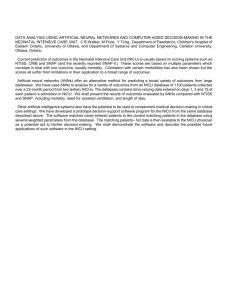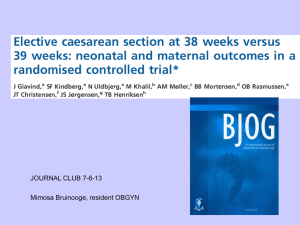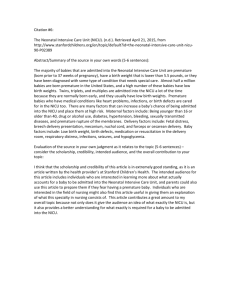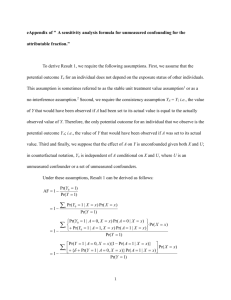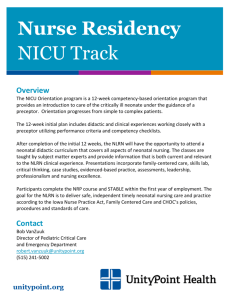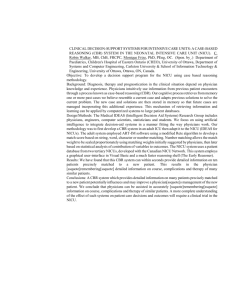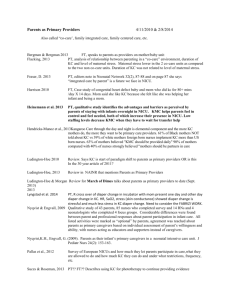The Importance of Unmeasured Casemix Differences when Evaluating
advertisement
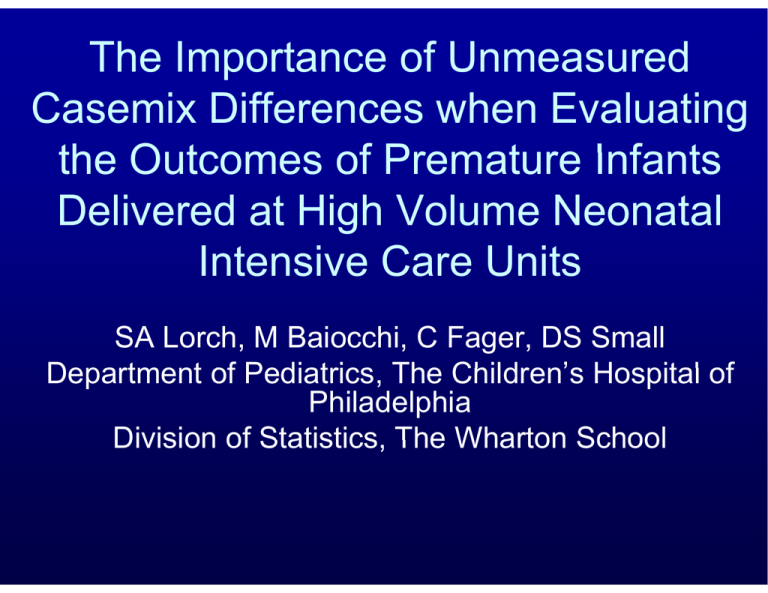
The Importance of Unmeasured Casemix Differences when Evaluating the Outcomes of Premature Infants Delivered at High Volume Neonatal Intensive Care Units SA Lorch, M Baiocchi, C Fager, DS Small Department of Pediatrics Pediatrics, The Children’s Hospital of Philadelphia Division of Statistics Statistics, The Wharton School Background • Neonatal intensive care units (NICUs) developed p in 1970s to manage g premature infants. • Because of the high costs costs, a “regionalized” system was proposed to organize the system. Studies on Regionalization • St Studies di off NICU NICUs suggestt th thatt outcomes improved at high-level NICUs. • Recently, y though, g many y states report p increased de-regionalization of neonatal care in the 1990s. • Few studies of the impact of this change. Limitations in Current Literature • Studies only examine mortality, not other morbidities • No data on state differences in this association • Studies do not account for unmeasured difference in casemix between NICUs. Traditional Casemix Adjustment • Regression R i Analysis A l i • “Adjust away” differences between hospitals Figure 1: The Impact of Regionalization on Neonatal Outcome Hospital Factors (quality) Structure Degree of Regionalization Access to Regional Perinatal Center Neonatal Outcomes in Region - Mortality - Complications - Failure-toRescue - Readmission Patient Factors (Severity, SES) • Examples of unmeasured factors include – Clinical data, data such as fetal heart tracing results – Severity of maternal comorbid conditions Unmeasured Confounding • 2 methods th d – Randomized Trial – Instrumental Variables Approach • Instrument has 2 characteristics: – Influences whether a patient receives the treatment of interest – Does not directly influence the outcome of patient, except by treatment of interest • May require some additional adjustment, for measured factors such as race or SES Instrumental Variables Conceptual Framework Figure 1: The Impact of Regionalization on Neonatal Outcome Hospital Factors Known Pt Factors Structure Degree of Regionalization Access to Regional Perinatal Center Neonatal Outcomes in Region - Mortality - Complications Failure-toto - Failure Rescue - Readmission Instrument A gold standard instrument is a random number used to determine treatment in a clinical trial. Objective T determine To d t i the th association i ti between b t delivery at a high-level NICU and neonatal outcomes before and after adjusting for unmeasured differences in casemix Patient Population • • • • • All deliveries 23-36 23 36 weeks gestational age 1995-2005 Pennsylvania, California, and Missouri “High-level High-level NICU NICU” = – Level III NICU – 50+ deliveries/year of infant with birth weight < 1500 grams Data Sources • Data Sources – Birth and Death Certificates – Maternal and Neonatal Hospital Records • D Data t li linked k d by b name, date d t off birth, bi th race, gender, insurance status, hospital, and zip code • Successful linkage of 98-99% 98 99% of all records. Outcome Measures • Neonatal death • Fetal death • Complications of premature birth – Bronchopulmonary Dysplasia (BPD) – Necrotizing g Enterocolitis (NEC) ( ) – Sepsis – Retinopathy of Prematurity (ROP) – Abdominal Surgery Confounding Variables • Maternal M t l Characteristics Ch t i ti – Age – Chronic medical conditions – Antepartum p complications p – Race – Education • Infant Characteristics – Birth Bi th W Weight i ht and d Gestational G t ti l age – Presence of Congenital Anomalies Instrument • Uses prior data that women tend to deliver at closest hospital. p • IV = difference in distance between high level NICU and nearest delivery hospital for a patient’s zip code • S Smaller ll number: b live li closer l to t high hi h level l l NICU, and should deliver at high level NICU att hi higher h ffrequencies i Data Analysis • Unadjusted U dj t d results lt • Measured casemix control: – Propensity score analysis • Unmeasured casemix control: – Instrumental variables approach, matching patients who live close and far from a high-level NICU on maternal and infant characteristics. • Analyses performed for each state individually. Demographics Pennsylvania California Missouri HL NICU Other NICU HL NICU Other NICU HL NICU Other NICU Differential Travel Ti Time (min) ( i ) 6 97 6.97 21 81 21.81 3 45 3.45 14 52 14.52 14 99 14.99 39 50 39.50 Birth Weight 2,473 2,724 2,716 2,935 2,649 2,853 Gestational Age 34.66 35.72 34.85 35.42 34.71 35.32 White 0.64 0.78 0.59 0.60 0.78 0.75 Black 0 22 0.22 0 09 0.09 0 10 0.10 0 06 0.06 0 19 0.19 0 23 0.23 Asian 0.01 0.01 0.09 0.09 0.02 0.02 Other 0.03 0.03 0.20 0.23 0.01 0.01 0.81 0.87 0.88 0.92 0.86 0.91 Preterm Labor 0 49 0.49 0 40 0.40 0 34 0.34 0 22 0.22 0 37 0.37 0 27 0.27 PROM 0.21 0.15 0.12 0.09 0.16 0.11 PIH 0.12 0.08 0.08 0.05 0.10 0.08 Race Singleton Birth Maternal Complication Strength g of Instrument Impact of Unmeasured Casemix on Outcomes, O t PA 1995 1995-2005 2005 Results, Unadjusted RD Neonatal Death Fetal Death 1 09% 1.09% 0.76% Results, adjusted for measured factors Results, adjusted for measured and unmeasured factors RR RD RR RD RR 1 88 1.88 -0.10% ( 0 21% 0 (-0.21%, 0.02%) 02%) 0.90 (0 78 1 (0.78, 1.02) 02) -0.99% ( 1 36% -0.61%) (-1.36%, 0 61%) 0.50 (0 32 0 (0.32, 0.69) 69) 2.73 -0.02% (-0.1%, 0.06%) 0.94 (0.71, 1.17) -0.05% (-0.29%, 0.19%) 0.92 (0.55, 1.29) Positive Risk Difference (RD) = higher mortality at highlevel NICU Negative Risk Difference = lower mortality at high-level NICU Impact of Unmeasured Casemix on Outcomes, O t PA 1995 1995-2005 2005 Results, Unadjusted RD BPD NEC Fungal Sepsis Bacterial Sepsis ROP ROP g y Surgery Laparotomy RR Results, adjusted for measured factors Results, adjusted for measured and unmeasured factors RD RR RD RR 1.86% 3.83 0.49% (0.37%, 0.6%) 1.69 (1.52, 1.85) 0.05% (-0.31%, 0.41%) 1.03 (0.83, 1.22) 0.63% 2.98 0.09% (0%, 0.17%) 1.25 (1.00, 1.49) 0.16% (-0.09%, 0.41%) 1.25 (0.86, 1.65) 0.77% 2.97 0.43% (0.32%, 0.54%) 2.07 (1.80, 2.33) 0.50% (0.24%, 0.77%) 1.77 (1.36, 2.17) 2.48% 1.94 0.19% (-0.03%, 0.41%) 1.07 (0.99, 1.15) 0.96% (0.40%, 1.51%) 1.28 (1.12, 1.44) 0.77% 3.28 0 5% 0.15% (0.06%, 0.24%) 1.44 (1.19, 1.70) -0.10% 0 0% (-0.35%, 0.16%) 08 0.87 (0.54, 1.21) 0.12% 3.79 0.03% ((-0.01%, 0.06%)) 1.58 ((0.87, 2.29)) -0.10% ((-0.21%, 0.02%)) 0.38 ((-0.33, 1.10)) 0.18% 1.97 0.02% (-0.03%, 0.07%) 1.18 (0.77, 1.59) -0.05% (-0.21%, 0.11%) 0.82 (0.26, 1.38) Unadjusted and Adjusted Outcomes Conclusions • Unmeasured differences in casemix contribute to lack of difference in outcomes between hospitals. • Different results depending on the outcome studied. • Large differences between states. Implications for Policy • Ignoring unmeasured casemix differences may provide support for a deregionalized system of perinatal care. • Delivery y location remains important to optimize perinatal outcomes. • The instrumental variables approach may improve the assessment of outcomes while awaiting future EHR methods to control for differences in casemix. Thanks • Departments of Health – California – Pennsylvania – Missouri • AHRQ R01 HS015696
